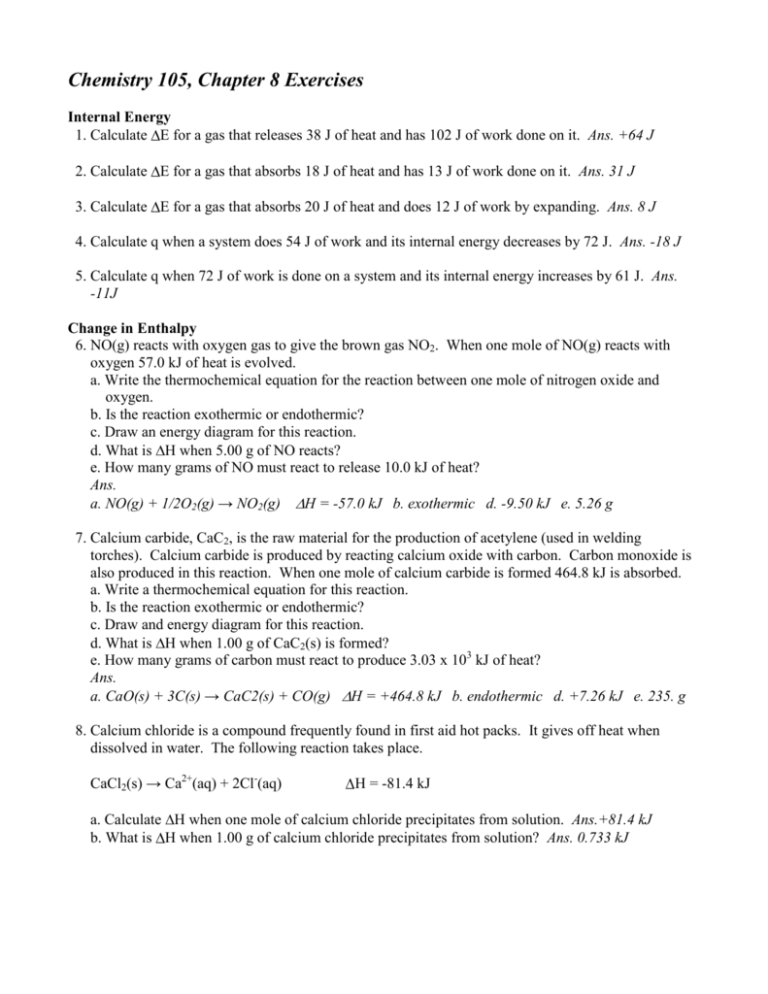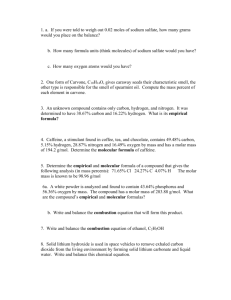Chapter 8
advertisement

Chemistry 105, Chapter 8 Exercises Internal Energy 1. Calculate E for a gas that releases 38 J of heat and has 102 J of work done on it. Ans. +64 J 2. Calculate E for a gas that absorbs 18 J of heat and has 13 J of work done on it. Ans. 31 J 3. Calculate E for a gas that absorbs 20 J of heat and does 12 J of work by expanding. Ans. 8 J 4. Calculate q when a system does 54 J of work and its internal energy decreases by 72 J. Ans. -18 J 5. Calculate q when 72 J of work is done on a system and its internal energy increases by 61 J. Ans. -11J Change in Enthalpy 6. NO(g) reacts with oxygen gas to give the brown gas NO2. When one mole of NO(g) reacts with oxygen 57.0 kJ of heat is evolved. a. Write the thermochemical equation for the reaction between one mole of nitrogen oxide and oxygen. b. Is the reaction exothermic or endothermic? c. Draw an energy diagram for this reaction. d. What is H when 5.00 g of NO reacts? e. How many grams of NO must react to release 10.0 kJ of heat? Ans. a. NO(g) + 1/2O2(g) → NO2(g) H = -57.0 kJ b. exothermic d. -9.50 kJ e. 5.26 g 7. Calcium carbide, CaC2, is the raw material for the production of acetylene (used in welding torches). Calcium carbide is produced by reacting calcium oxide with carbon. Carbon monoxide is also produced in this reaction. When one mole of calcium carbide is formed 464.8 kJ is absorbed. a. Write a thermochemical equation for this reaction. b. Is the reaction exothermic or endothermic? c. Draw and energy diagram for this reaction. d. What is H when 1.00 g of CaC2(s) is formed? e. How many grams of carbon must react to produce 3.03 x 103 kJ of heat? Ans. a. CaO(s) + 3C(s) → CaC2(s) + CO(g) H = +464.8 kJ b. endothermic d. +7.26 kJ e. 235. g 8. Calcium chloride is a compound frequently found in first aid hot packs. It gives off heat when dissolved in water. The following reaction takes place. CaCl2(s) → Ca2+(aq) + 2Cl-(aq) H = -81.4 kJ a. Calculate H when one mole of calcium chloride precipitates from solution. Ans.+81.4 kJ b. What is H when 1.00 g of calcium chloride precipitates from solution? Ans. 0.733 kJ 9. Consider the dissociation of water into ions. H2O(l) → H+(aq) + OH-(aq) H = 55.8 kJ a. Calculate H when one mole of water is formed from the ions. Ans.-55.8 kJ b. What is H when 1.00 g of water is formed? Ans. -3.10 kJ 10. Given, 2CuO(s) → 2Cu(s) + O2(g) Ho = 314.6 kJ a. determine the heat of formation of CuO, Ans. -157.3 kJ/mole b. calculate Ho for the formation of 13.58 g of CuO. Ans. -26.9 kJ 11. Given, 2Al2O3(s) → 4Al(s) + 3O2(g) Ho = 3351.4 kJ a. what is the heat of formation of Al2O3(s), Ans. -1675.7 kJ/mole b. what is Ho for the formation of 12.5 g of Al2O3(s). Ans. -205. kJ Specific Heat 12. Gold has a specific heat of 0.129 J/goC. If 5.00 g of gold absorbs 1.33 J of heat, what is the change in temperature of the gold? Ans. 2.06oC 13. Titanium has a specific heat of 0.523 J/goC. If 5.88 g of titanium absorbs 4.78 J of heat, what is the change in temperature? Ans. 1.55oC 14. When 5.00 g of chromium at 23.00 oC absorbs 62.5 J of heat, the temperature increases to 50.8oC. What is the specific heat of chromium? Ans. 0.450 J/goC 15. The specific heat of aluminum is 0.902 J/goC. If an aluminum pie tin weighs 473. g how much heat will it absorb when heated from 23.00oC to 375oC in an oven? Ans. 150 kJ 16. How much heat is required to raise the temperature of 1 gallon of water (3600 g) from 0oC to 45oC? The specific heat for water is 4.184 J/goC. Ans. 678 kJ Calorimetry 17. When 5.00 mL of ethyl ether, C4H10O, (d = 0.714 g/mL) is burned in a bomb calorimeter, the temperature rises from 23.5oC to 39.7oC. The calorimeter heat capacity is 10.34 kJ/oC. a. Calculate the quantity of heat evolved. Ans. -168. kJ b. Calculate the heat of combustion per gram and per mole. Ans. -46.9 kJ/g, -3.47 x 103kJ/mole, 18. Fructose, C6H12O6, is a sugar commonly found in fruit. A 4.50 g sample of fructose is burned in a bomb calorimeter. The heat capacity of the calorimeter is 2.115 x 104J/oC. The temperature in the calorimeter rises from 23.49oC to 27.71oC. a. Calculate the quantity of heat evolved. Ans. -89.3 kJ b. Calculate the heat of combustion per gram and per mole. Ans.-19.8 kJ/g, -3.57 x 103kJ/mole 19. When a 3.88 g sample of NH4NO3(s) dissolves in 60.0 g of water in a coffee-cup calorimeter, the temperature drops from 23.0oC to 18.4oC. Calculate H for the solution process: NH4NO3(s) → NH4+(aq) + NO3-(aq) Assume that the specific heat of the solution is the same as that of pure water (4.184 J/goC). Ans. +25.3 kJ 20. When a 9.55 g sample of NaOH(s) dissolves in 100.0 g of water in a coffee-cup calorimeter, the temperature rises from 23.6oC to 47.4oC. Calculate H for the solution process: NaOH(s) → Na+(aq) + OH-(aq) Assume that the specific heat of the solution is the same as that of pure water (4.184 J/goC). Ans. -45.7 kJ Hess's Law 21. Given the following thermochemical equations, C2H2(g) + 5/2O2(g) → 2CO2(g) + H2O(l) C(s) + O2(g) → CO2(g) H2(g) + 1/2O2(g) → H2O(l) H = -1299.5 kJ H = -393.5 kJ H = -285.8 kJ calculate the H for the decomposition of one mole of acetylene to its elements in their stable state at 25oC and 1 atm. Ans.-226.7 kJ C2H2(g) → 2C(s) + H2(g) 22. Given the following data, N2H4(l) + O2(g) → N2(g) + 2H2O(g) H2(g) + 1/2O2 → H2O(g) Ho = -534.2 kJ Ho = -241.8 kJ calculate the ∆H for the formation of N2H4(l). Ans.+50.6 kJ/mole N2(g) + 2H2(g) → N2H4(l) 23. Given the following thermochemical equations, 2H2(g) + O2(g) → 2H2O(l) H = -571.6 kJ N2O5(g) + H2O(l) → 2HNO3(l) H = -73.7 kJ 1/2N2(g) + 3/2O2(g) + 1/2H2(g) → HNO3(l) H = -174.1 kJ calculate the H for the formation of N2O5(g). Ans.+11.3 kJ N2(g) + 5/2O2(g) → N2O5(g) Heats of Formation Hfo's Data (KJ/mole) for Exercises 24-27: NH3(g), -46.1; NO(g), +90.2; H2O(g), -241.8; H2SO4(l), -814.0; SO2(g), -296.8; I-(aq), -55.2; Cl-(aq), -167.2; Cd2+(aq), -75.9; H2O(l), -285.8; SO42-, -909.3; H+, 0.0 24. Using Hfo's calculate Ho per mole of ammonia in the following reaction. Also, calculate Ho per gram of ammonia. Ans. -226.4 kJ/mole, -13.3 kJ/g 4NH3(g) + 5O2(g) → ammonia 4NO(g) + 6H2O(g) 25. Using Hfo's calculate Ho per mole of sulfuric acid in the following reaction. Also, calculate Ho per gram of sulfuric acid. Ans. +275.4 kJ/mole, +2.81 kJ/g 2H2SO4(l) → 2H2O(g) + O2(g) + 2SO2(g) 26. Using Hfo's calculate Ho per mole of chlorine in the following reaction. Also, calculate Ho per gram of chlorine. Ans. -224.0 kJ Cl2(g) + 2I-(aq) → 2Cl-(aq) + I2(s) 27. Using Hfo's calculate Ho for the following reaction. Ans. +35.0 kJ Cd2+(aq) + SO2(g) + 2H2O(l) → SO42-(aq) + 4H+(aq) + Cd(s) 28. Given the following data calculate Hfo for butane, C4H10(g). Ans. -124.7kJ/mole C4H10(g) + 13/2O2(g) → 4CO2(g) + 5H2O(g) Hfo H2O(g) = -241.8 kJ/mol Hfo CO2(g) = -393.5 kJ/mol Ho = -2658.3 kJ 29. Given the following data calculate Hfo for calcium cyanamide, CaCN2(s). Ans.-351.6 kJ/mole CaCO3(s) + 2NH3(g) → CaCN2(s) + 3H2O(l) Hfo CaCO3(s) = -1206.9 kJ/mol Hfo NH3(g) = -46.1 kJ/mol Hfo H2O(l) = -285.8 kJ/mol Ho = +90.1 kJ 30. Use bond energy values to estimate H for the following reactions. Average Bond Energies (KJ/mol) C=C 614 C=O 745 C=O in CO2 799 for each C=O C-C 347 C-H 413 C-Cl 339 Cl-Cl 239 C-N 305 N-H 391 O-H 467 H H C a. C H + Cl Cl H H H H C C Cl Cl H b. O C O + 2 N H Ans. a.-172 kJ b. +91 kJ H O H H N H C N H H + H O H







